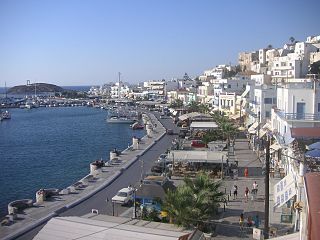Naxos, also known as Chora, is the capital of the island of Naxos in Greece, blending Cycladic charm with rich history. This picturesque town is adorned with narrow, labyrinthine streets, traditional whitewashed houses, and Venetian architecture. The majestic landmark, Portara, which is an ancient marble gateway standing on the islet of Palatia at the harbor entrance, offers a captivating sunset view. Rich in myth and tradition, Naxos Town also boasts of vibrant local culture, exquisite dining, and bustling markets that provide an authentic Greek island experience.
Explore the old market of Naxos Town for unique artisan products and local cheeses, perfect for an authentic taste of the island’s culinary heritage.
Make sure to visit the Archaeological Museum of Naxos housed in an old Jesuit college to delve into the island’s rich history from Neolithic to early Christian times.
Top things to do & see in Naxos
Select the following sights and activities to discover best tickets and tours available in Naxos.
Naxos: A Jewel in the Aegean Sea
| Country | Greece |
| Time in Naxos | GMT+2 |
| Language spoken | Greek |
| Population | 7,412 (source: Greece Population Data, 2021) |
| Currency | Euro (€, EUR) |
| Airports |
|
Naxos, or Chora, as it is known locally, is the capital and heart of Naxos Island in Greece. Its vibrant history is etched into the narrow alleyways and grand Venetian castles that dominate the town’s skyline. Known for its stunning landscapes and rich mythological past, Naxos appeals to both seekers of leisure and those enchanted by ancient lore.
Where is Naxos ?
Majestically setting on the western coast of Naxos island within the Cyclades group in Greece.
Distances:
| Route | Distance by car | Time by car |
|---|---|---|
| Athens to Naxos | 185 miles (combined drive and ferry) | Approx. 6-7 hours (including ferry ride) |
| Thessaloniki to Naxos | 510 miles (combined drive and ferry) | Approx. 10-11 hours (including ferry ride) |
What is Naxos famous for?
Naxos is renowned for its impressive Portara, the grand marble gateway to an unfinished temple of Apollo, which frames the sunsets perfectly making the city a prime spot for myth and natural beauty enthusiasts alike.
History
Ancient Period: Before 1000 BC – 323 BC
Naxos, known historically as one of the most significant cultural centers in the Cyclades, is thought to have been inhabited since the end of the 4th millennium BC. As the largest island in the Cycladic group, its strategic location and fertile lands made it an early center of civilization. Naxos became a major supplier of marble, which was exported across the Greek world. Notable contributions to culture include the establishment of monumental architecture and innovations in sculpture techniques.
Hellenistic Period: 323 BC – 31 BC
Following the death of Alexander the Great, Naxos experienced considerable Hellenistic influence. During this era, the city expanded its trading networks, enriching its local arts and architecture. New building techniques from the Hellenistic world transformed the urban landscape, evidencing increased wealth and prosperity.
Roman and Byzantine Period: 31 BC – 1204 AD
Under the Romans, Naxos maintained its prosperity, primarily through trade. As the Roman Empire transitioned into the Byzantine Empire, Christianity began spreading across the region, leaving a profound impact on the local culture. Numerous churches and religious artifacts from this period still exist, showcasing the Byzantine architectural prowess and artistic heritage.
Venetian Rule: 1207 – 1566 AD
The island was taken over by the Venetians in 1207, leading to the establishment of the Duchy of the Archipelago. Naxos flourished as a cosmopolitan center of commerce and art under the Venetian nobility, creating a unique cultural blend of Greek and Venetian elements. The iconic Castle of Naxos, or Kastro, was built during this period, serving as an administrative center and residence for the Venetian rulers.
Ottoman and Modern Period: 1566 AD – Present
Naxos came under Ottoman rule in the 16th century, though it retained a degree of autonomy thanks to its remote location and formidable naval power. With the advent of Greek independence in the 19th century, Naxos ultimately became part of the new Greek state. Today, Naxos Town is celebrated not only for its storied past but also for its vibrant present, balancing modern tourism with rich historical roots.
Visit Naxos
Attractions and Activities in Naxos
Naxos, with its rich blend of history and culture, offers a diverse array of attractions. Visitors can explore the imposing Venetian Castle at the heart of the town, which provides panoramic views of the Aegean Sea and surrounding areas. The Archaeological Museum of Naxos, located within the castle, displays artifacts that trace the island’s history from the Neolithic to the Paleochristian period. Not far from the town center lies the iconic Portara, the massive marble gateway that stands as a remnant of an unfinished temple dedicated to Apollo.
- Explore the Venetian Castle
- Visit the Archaeological Museum
- Walk through the ancient Portara
Festivals and Celebrations in Naxos
Naxos hosts a range of cultural events and festivals, particularly vibrant during the summer months. The Naxos Festival at Bazeos Tower is a highlight, featuring music, theatre, and art exhibitions from July to September. Another notable event is the Dionysia festival, celebrating the island’s rich agricultural produce and winemaking tradition with plenty of feasting and dancing, typically held in late August.
Best time to visit Naxos
The best time to visit Naxos is during the late spring to early fall, from May to October, when the weather is warm and sunny, perfect for exploring the island’s natural and historical sites.
Is Naxos worth visiting?
Naxos is unquestionably worth visiting for its unique blend of ancient history, stunning architectural sites, and vibrant cultural scene. The town offers a profound journey through time, from ancient ruins and medieval castles to contemporary art exhibitions. Coupled with its beautiful beaches and hospitable locals, Naxos provides a rich and rewarding experience for all who visit.









